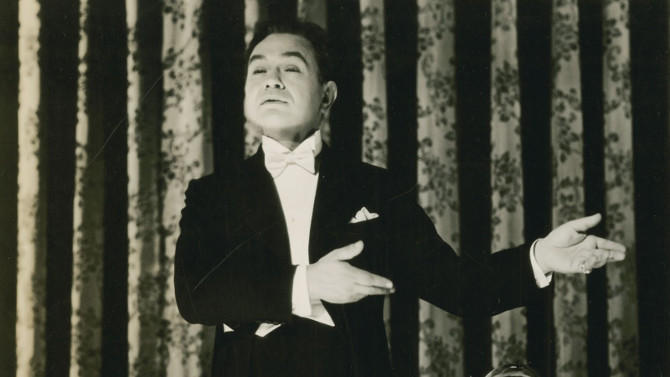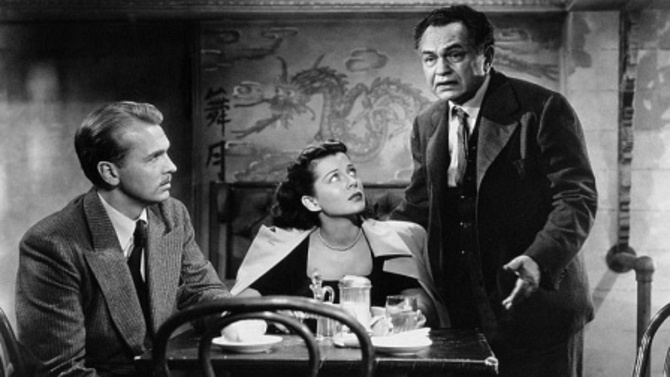Twisting the twinkling night sky into a harbinger of doom, 1948’s Night Has a Thousand Eyes is a classic film noir that delves into the inexplicable realm of parapsychology.
Based upon a novel of the same name written by iconic crime scribe Cornell Woolrich (and adapted by Barré Lyndon and Jonathan Latimer), John Farrow (Where Danger Lives; Around the World in 80 Days) directs this intriguing story. Opening in dramatic fashion, we witness a last second rescue of a young woman attempting suicide late one night at a bustling industrial railway depot (a stunning visual sequence).
She is a wealthy socialite, Jean Courtland (Gail Russell), and is rescued at the very last moment by her protective beau Elliott Carson (John Lund). Cynicism, and perhaps rightfully so, oozes from this suspicious young man, for the person who gave him the information (of where to find his suicidal girl) is a supposed soothsayer named John Triton (Edward G. Robinson).
Reclusive for the past twenty years due to this menacing weight that has been placed upon his shoulders, the middle aged man recounts his story to the young couple. Seeming like a tale of doomed predestination, he tells of his history with Jean’s parents, Jenny (Virginia Bruce) and Whitney (Jerome Cowan).
Ironically, Triton was a phony fortune teller, the triumvirate having a popular show that toured the country. . . that is, until one fateful day, the star performer was struck with a vision in his head – something that mysteriously came true.
Unable to shake the guilt that this power has left on his soul, even after making the threesome a load of cash, the man is especially jarred after seeing a vision of Jenny’s possible outcome (originally, Triton was engaged to Jean’s mother). Fleeing to find some sanity (and in hopes that this noble gesture will somehow change the outcome of her future), Triton has lived as a hermit for a fifth of a century. . . until being brought back into the fold after another alarming premonition.
Seeing the death of Jean in his mind’s eye, this could finally be a chance for Triton to change fate. Yet, standing in his way is the still unbelieving Elliott as well as the police, who are now involved in the situation. With unyielding Lt. Shawn (William Demarest) in charge, Triton is treated more as a criminal than some sort of future-seeing witness. With a very specific set of events that will occur in order, can the annals of fate be changed?
A fascinating vision of the mysterious veil that separates life and death, Edward G. Robinson brings this man, who is somehow stuck in the middle, alive. Living in a sorrowful and worrisome fugue state of self-doubt, he feels cursed by this power (that some may see as a blessing). Never able to change what has been foretold, Jean’s life is in many ways a stand-in for the only love of his life (her mother), and, likewise, it is also akin to him trying to save his own daughter’s life as well.
Fearing the twinkling eyes of the night’s sky, Triton has, perhaps a tad brashly, warned young Jean that her death will occur beneath them. Like a constant reminder of her impending doom, it is why she originally tried to commit suicide that one evening. Triton’s past, present and future is interwoven with Jean and her family’s, and it is likely that he will play an integral part in it. . . whether that means death by starlight or love by moonlight.
Richly woven, the Woolrich adaptation perfectly encapsulates the noir motif of a certain dark fate. Bringing me back to a hard-boiled quote from Fred MacMurray’s Walter Neff in 1944’s Double Indemnity, he too channelled some sixth sense of impending death, “Suddenly it came over me that everything would go wrong. It sounds crazy, Keyes, but it’s true, so help me. I couldn’t hear my own footsteps. It was the walk of a dead man.” It seems only fitting that the character he is talking to (Keyes), is also played by Robinson. And, like in this more famous `44 offering, we watch in gripping fascination as things, despite the seeming impossibility, drive to a predestined fate. A flower is stepped on, an unexpected wind roars from nowhere, the clock chimes 11, a lion’s paws are seen. . . but, will each of the pre-warned steps toward death actually lead to a very finite ending. . . well, that’s up to you to find out.
An intriguing lesser known noir (that throws in several moments of surprising humour), Night Has a Thousand Eyes draws the viewer in by way of its fascinating look at a doomed prediction. Also encompassing the things that make this sub-genre great, expect moments of stellar cinematography and visuals (actually, the original Angel’s Flight on Bunker Hill in downtown Los Angeles features in one sequence). The last noteworthy fact is that the score, written by Victor Young, was transformed into a song composed by Jerry Brainin, with lyrics by Buddy Bernier – a jazz standard that has been recorded by John Coltrane, Sonny Rollins, Harry Belafonte, Petula Clark, and a slew of other greats. So, attend a show from the great Triton and learn whether those twinkling eyes will cry on this fateful night.



